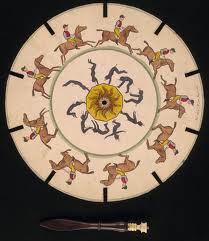 The first moving image was introduced to the television in 1926 by John Logie Baird. This was based on the old idea of Persistence of Vision (PoV). PoV is the theory that the eye has a retention of an image of about 1/25th of a second and therefore if a secondary image was viewed before this persistence ends then the observer would not notice the change of images.
The first moving image was introduced to the television in 1926 by John Logie Baird. This was based on the old idea of Persistence of Vision (PoV). PoV is the theory that the eye has a retention of an image of about 1/25th of a second and therefore if a secondary image was viewed before this persistence ends then the observer would not notice the change of images.The image shows an early toy called the Zeotrope which created the illusion of motion. This was invented in 180AD and then a modern version was reinvented in 1833. The viewer looked through the slits and because of the speed at which the images were rotating it created the illusion of motion despite it actually being a series of still images.
This theory is now regarded as the myth of persistence of vision. The more plausible theory now is that there are two distinct perceptual illusions in phi phenomenon and beta movement.
Bitrate is the word used to describe how many bits are required to show a video per second. This can vary from as low as 300kbps sor a low quality video, upto 8000kbps for a high quality video.
Interlacing is a way of getting the best results from a low bandwidth. It is done by alternating showing the odd numbered lines on the television first, then the even numbered lines of the next image at a speed of 25 frames per second. This gives the illusion that the images are moving.
Resolution is the number of pixels a televison can display. When analogue TV was used, typical resolution was 352x288 in Europe. Comparitively, modern televisions can display as many as 1920x1200. DVD quality is typically 720x576 for European televisions, while Blu-Ray and HD provide the highest resolution.
File Format
MPEG-1 - First designed in 1988 was the first decoder and could compress a video to about 26:1 and audio 6:1. Designed to compress vhs quality raw data with minimum loss in quality.
MPEG-2 - The improvement to MPEG-1 and is the format of choice for digital television broadcasters. It actually developed as early as 1990 before MPEG-1 was released.
MPEG-4 - Integrates many features of previous versions while adding support for 3-D rendering, Digital Rights management and other interactivity.
Quick Time - Appeared in 1991 created by Apple almost a year before Microsofts equivalent software.
It can handle playback from VLC and MPlayer both which are PCLinuxOS based.
AVI - Appeared in 1992 by Microsoft. A problem with this format was that it could appear stretched or squeezed during playback however the players such as VLC and MPlayer solved most of these problems. But a massive advantage of it is that it can be played back on almost every player and machine making it second only to MPEG-1.
WMV - Made by microsoft using several codecs and is used for BluRay discs.
3GP - Used for CDMA phones in the US. Some phones us MP4.
FLV - Used to deliver video over the internet and is used by YouTube, Google Video, Yahoo Video, Metacafe and other news outlets.
No comments:
Post a Comment